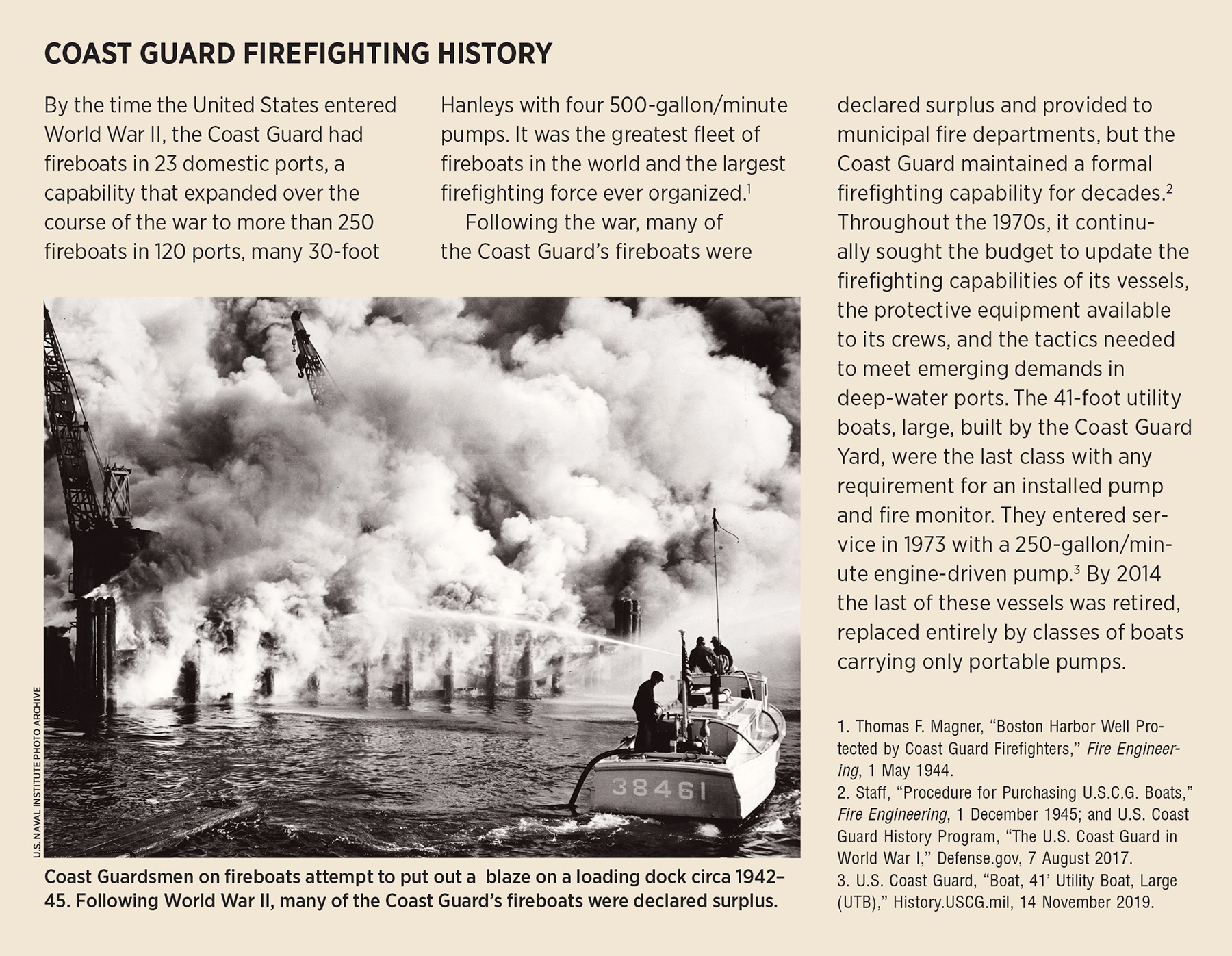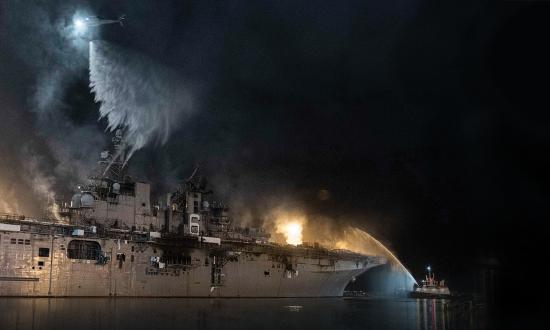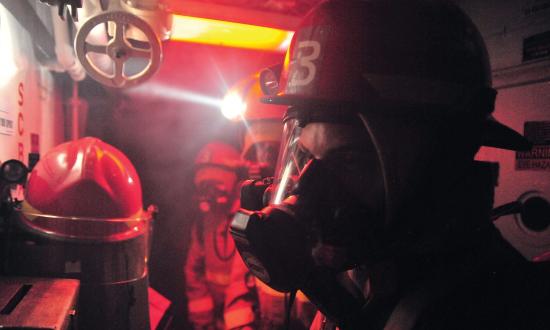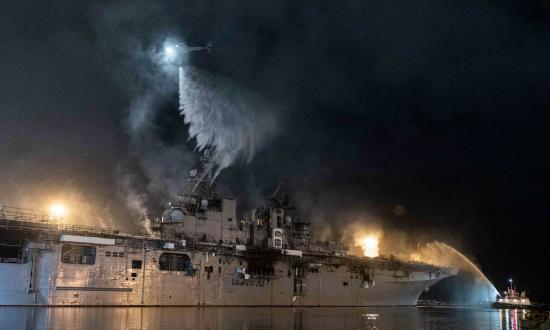The Coast Guard does not fight fires. That is the official policy—at least for fires that break out on board vessels that do not fly a Coast Guard ensign. Instead, the service provides “assistance as available” and serves as “an important resource” to firefighting organizations through its development of written contingency plans for each major port.”1 Yet Coast Guard boats and cutters respond annually to hundreds of at-sea and waterfront fires involving private, commercial, and public property, so many that such cases rank high among the reasons for search-and-rescue sorties.
Considering the history of the Coast Guard, which from its formation until the late 1970s fielded purpose-built fireboats to combat fires at ports nationwide, how did the nation’s lead maritime responder devolve into having only a minimalist regulatory and planning role in regard to fire? And after a series of deadly and devastating marine fires in recent memory, should firefighting become a renewed priority for the service?
The Conception and the State of Marine Firefighting
A case that perhaps best illustrates the current state of marine firefighting is the tragedy of the M/V Conception.
When fire broke out on the Conception, a 75-foot dive boat operating off the coast of Santa Cruz, California, in September 2019 with 39 persons on board, the vessel’s captain transmitted a Mayday for an unspecified distress situation then jumped into the sea. This broadcast was received by watchstanders at an onshore Coast Guard command center, who then took eight minutes to issue an Urgent Marine Information Broadcast soliciting the aid of any vessels in the area and to notify the nearest Coast Guard boat and air stations.
The Coast Guard boat station, with no on-duty emergency medical technician (EMT) or paramedic, requested such capability from the local fire department and delayed its response until one could arrive, despite the launch of a service helicopter with an embarked EMT and rescue swimmer. When a responding Good Samaritan vessel reported the Conception was on fire, the boat station immediately launched its first asset, 28 minutes after the initial report.
A second boat with a fire department EMT and paramedic responded 7 minutes later. Shortly after, the local police, harbor patrol, and a commercial salvor launched their own boats. The first government asset to arrive on scene did so 1 hour and 18 minutes after the initial report.
Though both 45-foot Coast Guard boats that responded carry 250-gallon/minute portable pumps intended for use to dewater a hull or to fight a fire, the crews did not engage them in independent firefighting. Instead, following service policy, both crews deferred to local fire department officials, who ruled the Coast Guard pumps would be ineffective. Firefighting efforts were delayed until the arrival of the harbor patrol’s fireboat, nearly two hours after the initial report. In the end, the fire claimed the lives of all 33 passengers and one crewman, and the vessel was a total loss.2
This is not to imply any responder acted inappropriately, outside of policy, or with anything but full commitment to their duty to save lives. The intent instead is to establish the conditions and policies under which these responders work and to propose improvements.
Because burns and smoke inhalation are expected during a fire, the ability to competently attend to and treat these injuries is an important element of marine firefighting capability, one Coast Guard boat crews lack—to the detriment of response times, as they wait for the arrival of local emergency medical services. In a similar vein, the watchstanders’ and crew’s lack of knowledge or understanding that an EMT was on board the service’s responding helicopter indicates an unnecessary reliance on local government agencies.
Local fire officials’ assessment that the firefighting pumps on board the Coast Guard boats would be ineffective and their decision to keep them stowed are notable. The harbor patrol fireboat provided a 1,500-gallon/minute pump, a supply of firefighting foam, and an engine company of local government firefighters, but these took more than two hours to arrive on scene.Had both Coast Guard pumps been rigged and started on arrival, more than 500 gallons/minute of water could have been immediately delivered to the base of the flames.The Coast Guard pumps were certainly inferior to those of the fireboat, but they do have firefighting capability and well exceed Safety of Life at Sea treaty requirements for emergency fire pumps.3
Though many local jurisdictions operate fireboats, less than 4 percent of U.S. firefighters are trained in marine firefighting techniques, meaning most are unlikely the best decision-makers in such cases.4 In contrast, any Coast Guardsman having done a tour on board a cutter is well drilled in the equipment and tactics of marine firefighting and well aware of the unique dangers of fire at sea. Yet, Coast Guard policy prohibits independent firefighting by Coast Guard assets and defers decision-making authority on combating marine fires almost entirely to local fire officials. Coast Guard firefighting capability undoubtedly could be increased with the installation of higher power pumps and the carriage of foam on board the service’s boats, but without the authority to employ them there is little utility.
In addition to the physical response to the Conception fire is the regulatory role the Coast Guard played in certifying the vessel as safe to carry passengers. The Coast Guard is responsible for implementing regulations addressing fire prevention on board passenger vessels, including mandates for night watches, the frequency of fire drills, and the training of crews. Vessels that carry more than 12 passengers for hire are required to hold a Certificate of Inspection (COI) issued following a physical inspection of the vessel by the Coast Guard for compliance with federal regulations—many established by the service—including those related to fire prevention and response.
Though the Conception was issued a COI, a lawsuit filed against the Coast Guard by the families of those who died alleges the service failed to enforce the regulations and allowed the vessel to operate with blatant violations that ultimately resulted in the loss of life.5 Such accusations of nonenforcement are not new, and in 2017 the Coast Guard’s Assistant Commandant for Prevention Policy testified during a congressional hearing that the service lacks the resources to enforce the regulations it establishes. Information presented during the hearing indicated the Coast Guard had failed to enforce basic firefighting regulations for more than a decade and that local tug boats and other vessels of opportunity were generally relied on for firefighting response nationwide, though they often are unavailable because they are under contract to perform other jobs or lack the crew and vessel endorsements for offshore operations. Such factors have resulted in vessels burning unmitigated for days or being towed into port to allow municipal fire departments to fight them from the pier.6
With only major ports fielding full time fireboats, tugs unavailable for response or significantly delayed, and the Coast Guard operating under a self-imposed prohibition on independent firefighting, a giant dead zone with no emergency fire coverage exists along much of the coast—and worsens as distance from shore increases.
A Way Ahead
Plans to extinguish fires and save lives and property are meaningless without the assets and personnel to execute them. Area contingency plans such as that developed for the port of Savannah, Georgia, recognize this in part. When no municipal fire department is able to respond or has jurisdiction, they place responsibility for assuming command for a burning vessel underway or at anchor on the Coast Guard captain of the port. When a municipal fire department is available, however, the responsibility for controlling firefighting operations is deferred to that agency’s official.7 This conforms to the Federal Fire Prevention and Control Act of 1974, which states fire is and should remain a state and local responsibility.
Trouble is, the Coast Guard has jurisdiction over all navigable waterways while most municipal jurisdictions end within three nautical miles of the coast, leaving large swaths of water unprotected. This is particularly worrisome when regulations related to contracting firefighting services are not being enforced and the commercial tugs identified as firefighting assets prove unavailable or ill equipped.
The Coast Guard is responsible for the overall safety of the nation’s ports and is its de facto marine firefighting agency, as evidenced by the plans it develops. Yet it inhibits performance of that duty by adhering to internal policies that defer firefighting command and control to municipal officials, most of whom lack experience in marine firefighting.These policies further allow decisions that limit the firefighting capabilities of the service’s fleet and, worse, deny their crews the authorization to engage in independent firefighting at the onset of fires.
Recent tragedies have shown the need for the Coast Guard to revisit its stance on firefighting, not to supplant municipalities or absolve them of their responsibilities, but to support them with real capabilities and expertise and to provide capability in unprotected waters to avert tragedy. The Coast Guard trains and equips its cutter crews to combat fires on board their own vessels, the success of which was recently demonstrated on board the cutter Waesche (WMSL-751) during a Pacific transit.8 Now it needs only to increase the capacity and foam-delivery capability of the pumps carried on its boats, expand the training and equipment available to its boat crews who operate in coastal regions where fire poses the greatest threat, and revise policies that limit involvement and inhibit on-scene decision-making even in unprotected waters.
Though the nation may not require a dedicated fleet of fireboats, recent events and a long history of marine fires show it would benefit from a multimission fleet capable of fighting fires and enabled to act without having to seek out and defer to a municipal official. The Coast Guard has 1,400 boats available, all crewed by personnel whose duty is to respond at any time and in any weather to distress situations. These are the professionals the nation should be able to rely on to save its vessels and waterfronts from fire.
1. National Fire Protection Association, NFPA 1925, “Standard on Marine Fire-Fighting Vessels.”
2. National Transportation Safety Board, “Fire Aboard Small Passenger Vessel Conception, Investigation Details.”
3. Anish, “A Guide to Fire Pumps on Ships,” Marine Insight, 26 July 2021. Passenger ships of more than 1,000 gross tons must carry a minimum of one independently powered emergency pump capable of delivering at least 110 gallons/minute over a horizontal throw of more than 40 feet.
4. U.S. Fire Administration, Special Report: Fireboats: Then and Now (Department of Homeland Security, May 2003).
5. City News Service, “Families of 34 Victims Killed in Deadly Conception Boat Fire Sue Coast Guard in Los Angeles,” Fox11, 2 September 2021.
6. gCaptain, “U.S. Coast Guard Admiral Admits to Not ‘Aggressively Enforcing’ Firefighting Rules,” 25 May 2017.
7. U.S. Coast Guard, “MSU Savannah Area Contingency Plan,” revised June 2016.
8. “Photos: USCG Cutter Waesche Suffers Stack Fire at Sea,” The Maritime Executive, 23 September 2020.








